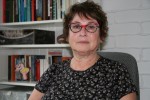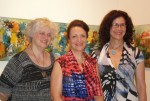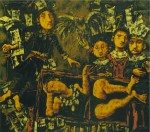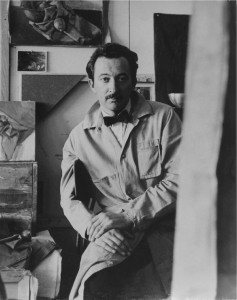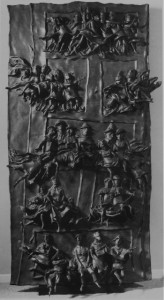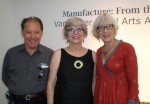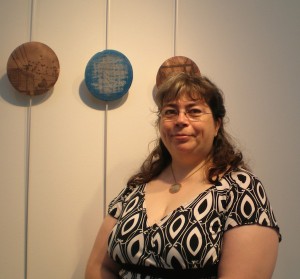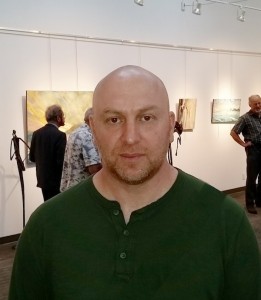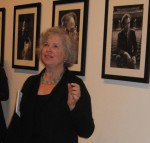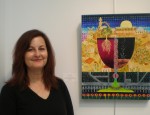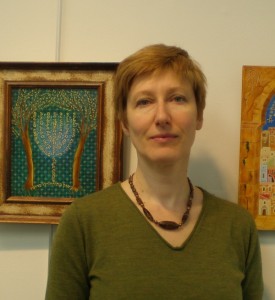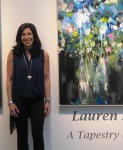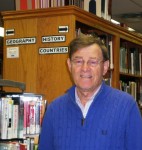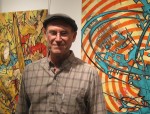Winnipeg artist Reva Stone is interested in “examining ideas about the mediation between our bodies and the technologies that are altering how we interact with the world.” (photo by Harold Stone)
The International Symposium on Electronic Art comes to Vancouver Aug. 14-19. One of the artists featured in this “showcase of creative productions applying new technologies in art, interactivity, electronic and digital media” is Reva Stone.
It should come as no surprise, with Stone’s artwork comprising computer-assisted installations since 1992, that she has been invited to participate in ISEA once again. The first time Canada played host to the international symposium was in Montreal in 1995 and the Vancouver event marks only the second time that it has come to our country. In the last four years, it has been hosted in Istanbul, Albuquerque, Sydney and Dubai.
Stone, 70, was born to Sarah and Don Atnikov in Winnipeg and raised in Regina before returning to Winnipeg for university, earning a bachelor’s in sociology and psychology in 1966 and a bachelor of fine arts in 1985. She has been a professional electronic and digital media artist for more than 25 years.
“As far back as I can remember, I was always interested in making art, but it wasn’t seen as a practical decision when I was in university in the early 1960s,” said Stone. “By my early 30s, I was married [to Harold Stone] and a stay-at-home mom with two children. I was taking local art classes, but not finding them satisfying. I needed to learn more, experience more and experiment more.”
Stone returned to school to take fine arts. “I thought I was going to become a painter, but that didn’t last long,” she recalled. “I learned quickly that I love to take chances and am really comfortable trying things I have never done before.”
She graduated when she was in her 40s and was told that a woman her age could not have an art career. So, she said, “I did it anyways. Since that time, I have been creating computer-assisted installations that explore the mutable space between human and machine.”
Stone always begins new work with a concept that she has read about or an occurrence that she has observed, developing her ideas through research and experimentation. Each work comes to fruition, sometimes in collaboration with other artists and scientists, and other times with hired computer programmers. Stone has shown her work across Canada, the United States and Europe.
In addition to ISEA2015, Stone’s work is featured in the 2015 Governor General’s Awards Exhibition at the National Gallery of Canada, which runs to Aug. 30, and will be at Gurevich Fine Art in Winnipeg in September, as part of the exhibit A Celebration of Women’s Art.
The Winnipeg show includes the work of her studio partners, Aganetha Dyck and Diana Thorneycroft. “We have shared space for over 20 years and this is the first time we are showing together,” said Stone.
“My interest is in researching and examining ideas about the mediation between our bodies and the technologies that are altering how we interact with the world,” explained Stone. “I then use various forms of digital media to make artwork that comments on this changing nature of what it means to be human.”
Stone’s art has encompassed works such as “Imaginal Expression” (an endlessly mutating, responsive, 3-D environment), “Carnevale 3.0” (an autonomous robot that reflects on the nature of human consciousness) and “Portal” (which combines custom software, media, robotics and mobile phone technology to create a work that appears to be sentient).
“Recently, I began altering and repurposing obsolete devices that refer to the history of communication and technology,” said Stone. “I am altering them by adding small, embedded computer boards, video screens, lights, sensors, custom software, robotics and found video.
“I am choosing objects that possess an historical richness that merges with the alterations I am making to create a rich layering of ideas. As I continue to explore this series of work, I am finding that humor and a sense of play have become an increasingly important element.”
Over the years, Stone has received numerous research and production awards, including from the Canada Council for the Arts, the Major Arts Award from the Manitoba Arts Council and, of course, the Governor General’s Award in Visual and Media Arts this year.
She has also been internationally recognized. In 2002, for example, “Carnevale 3.0” received an honorable mention in Fundación Telefónica’s Vida 5.0 Art and Artificial Life International Competition. In 2009, Stone presented at Super Human – Revolution of the Species Symposium, organized by the Australian Network for Art and Technology in Melbourne. The proceedings were published in Second Nature: The International Journal of Creative Media.
The theme for ISEA2015 is “Disruption,” inviting “a conversation about the esthetics of change, renewal, efficiencies and game-changing paradigms.” Conference events will be held at the Woodward’s campus of Simon Fraser University, with exhibitions and events taking place at Emily Carr University of Art + Design and other venues throughout the city.
Vancouver Art Gallery’s Fuse event will be held in partnership with ISEA2015 on Aug. 15. In addition to music and live performance, the works of some 50 artists will be on display, including that of Stone. The event is open to the public starting at 8 p.m. (tickets are $20 plus tax). For more information, visit isea2015.org/schedule.
Rebeca Kuropatwa is a Winnipeg freelance writer.

